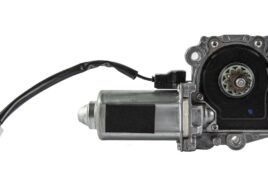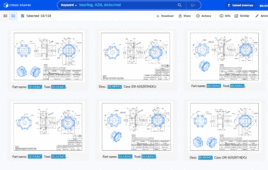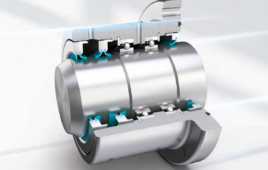by Cathy Hayat/ Hexagon Metrology, Inc.
At the competitive edge of every professional sport, the margins of victory are often tiny differences in energy, efficiency, skill and physical configuration. Over time, this gives rise to elaborate regulations governing competitors’ behavior, their contests, component designs, and the unending attempts to create a winning edge by stretching the rules. In response, NASCAR adopted sophisticated methods to verify a racecar’s dimensions at its research and development facility in Concord, NC. After using Hexagon Metrology’s proprietary GridLOK technology, NASCAR officials felt confident they could inspect a car to tighter tolerances.

Hendrick Motorsports races four full-time Chevrolet teams in NASCAR’s Sprint Cup series
GridLOK is a spatial coordinate system configured to work by treating its entire workspace as a large invisible coordinate system, effectively creating a giant CMM. Adopted in response to safety concerns, fair competition, and cost management; in 2007, the introduction of the Car of Tomorrow (CoT) implemented new standards, which necessitated a more rigorous means of enforcing specifications with tighter tolerances as compared to prior generations of racecars.
Metrology became an essential part of the build process once NASCAR brought tighter tolerances into play. To replicate verification procedures right down to the equipment used, Hendrick Motorsports (Concord, NC) invested in 12 ROMER portable coordinate measuring machines (CMMs) of varying styles and sizes from its official partner for dimensional metrology products and services. The arms are used for tactile probing and laser scanning of the car bodies, guarantying they fall within NASCAR’s required tolerances. Though most measurements are taken with touch probes to verify specific points, the racetrack also equipped some of the arms with the CMS108 laser scanner to inspect complete car bodies. Careful to stay within the required specifications, the four Hendrick teams maxed out tolerances to gain every possible ounce of performance.
GridLOK drives accuracy
Hendrick implemented the GridLOK system to guarantee its portable measuring processes precisely matched those of NASCAR. To initially construct this CMM, engineers installed numerous small (5/8 in. diameter) conical seats in a grid pattern, which typically spans 4 x 6 m. The seats are either mounted in a concrete floor or steel plate—Hendrick chose the steel plate option. Once installed, engineers entered their coordinates into the inspection program using a precision laser tracker as a guide. The grid contains a volumetric repeatability of ±0.002 in., and the stage was set for the articulating arm.
To measure an object in the system, an operator took the arm and touched any three conical seats. The arm recognized its position in relation to other seats, locked onto a common origin and assigned the proper 3D coordinates. Once a section of a part is measured and the data are imported into the software, the operator then moved to the next section. Points were acquired from three other conical seats and the arm “understands” where it is relative to the previous set of points. Data from that section is imported into the software, and the process continues until complete. Hendrick uses 13 GridLOK plates for chassis manufacturing, body manufacturing, racecar setup and final racecar body measurement before loading the car for an event.

ROMER arms are used to assist in precisely attaching the body panels to the racecar
Framework for precision
To compete in NASCAR’s 36-race schedule, each of the four teams has 14 cars in its fleet. All 56 cars are repeatedly measured to check dimensional accuracy. In years past, internal components were measured as a means of quality control. With the implementation of portable CMMs, quality control expanded into body components, as well as fabrication, assembly and reverse engineering. Hendrick has evolved the use of the arms to the final suspension set up of the racecar in preparation for competition. The use of the portable CMMs and the system has increased the accuracy of the racecar assembly.
In-house measurements also are taken to guarantee the racetrack’s proprietary chassis are built to the design intent and will pass NASCAR’s inspection. To enforce CoT specifications, a rigorous chassis certification process checks more than 220 specific points. All points measured need to be within ±70 thousandths of an inch of NASCAR’s nominal figures. Every Sprint Cup chassis must be certified for the race, and, in the event of an accident, recertified before approved to return to competition at Hendrick’s. The high-tech inspection process allows NASCAR to identify and maintain records of each unique chassis.
Once the chassis is officially certified, ROMER arms assist in precisely attaching the body panels to the racecar and verify the completed car will conform to NASCAR’s tolerances. A completed chassis fitted with body panels is delivered to the Nos. 5 and 24 shops or the Nos. 48 and 88 shops. After the body and chassis arrive, measurements are taken throughout the finish fabrication and painting process. Each shop has four dedicated operators (two per car) to measure external features. Ensuring quality standards is a rigorous job when there are millions of dollars on the line.

To measure an object in the system, an operator took the arm and touched any three conical seats.
Only the first lap
The decision to adopt the measurement system was twofold. Hendrick had been measuring internal components, such as engines and transmissions, using bridge CMMs, but realized more data were needed on the car bodies. Then, when the CoT was introduced, this cemented Hendrick’s decision to adopt the system to mimic NASCAR’s capabilities. Once the organization discovered the applications supported by the GridLOK system and portable arms, the company started formulating ways to improve the entire car’s performance.
The expanded use of the arms to perform final suspension setups of the racecars has helped the Hendrick’s teams in two primary ways. First, the technicians were able to precisely meet the crew chiefs and team engineers desired setup and tolerances. Second, these accurate datapoints allowed Hendrick to assess and correlate its analytical tools. The company employs two Brown & Sharpe Global Advantage CMMs to measure results as they relate to key engine components. Though the arms are used throughout the assembly process, several parts, including engine components, are measured on the bridge CMMs since high precision measurements are essential in their manufacture and assembly. For example, Hendrick assembles approximately 700 engines each year to power its 56 racecars, as well as those of various customers.
Enhancing performance even carries through to the driver’s seat. During carbon-fiber seat fabrication, a mold is poured while the driver sits in the frame so the liner conforms to his body. The liner is then laser scanned and a custom 3D model is created to duplicate the liner as many times as needed. When driver Kasey Kahne joined the team, he brought seat liners from his previous team. Since that time, NASCAR mandated a change to the seats, which modified the thickness of the material and affected the way it came out of the mold. The narrower seats were uncomfortable around Kahne’s ribs, and the crew found the discrepancy by scanning the liners to make the necessary adjustments.
Metrology has proven itself to be a critical tool in the Hendrick’s toolbox. Given the fact that this company operates in a highly competitive industry, the teammates are challenging themselves constantly to engineer a performance edge using creative solutions. When that performance meets the racetrack, the results are nothing less than amazing.
Hexagon Metrology Inc.
www.HexagonMetrology.us
Filed Under: Automotive





Tell Us What You Think!